Shes My Van Gogh Such a Work of Art

'People say that it is difficult to know oneself but it's not easy to pigment oneself either'
Excerpt from a letter of the alphabet from Vincent van Gogh to his brother Theo, September 1889
My outset introduction to the Dutch painter Vincent Willem van Gogh was at school. A tortured artist who cutting off his ear and painted thick, brightly coloured swirly paintings.
He felt dramatic, passionate and extreme.
12-twelvemonth-olds tend to desire to produce fine art that looks more realistic, and so I think at the time, I wanted to try and paint like Cezanne. Cezanne's still life'due south hit the dizzy heights of being recognisable notwithstanding achievable, with a nice painterly style.
Merely thinking back, I probably felt I was being sophisticated and different; copying Van Gogh every bit a young painter seemed besides obvious.
It wasn't until an art trip at 16 to the National Gallery, London that I rediscovered the Sunflowers…

Vincent van Gogh, Sunflowers, 1888. (Van Gogh signed his works 'Vincent' because people had trouble pronouncing his surname.)
In real life, Sunflowers take got such a huge draw. The painting has got a great composition, and the palette is harmonious.
Simply mostly, I loved how thick the paint was.
I painted very thinly, mainly because I didn't accept any money as a immature art student. But I idea that it was so fantastic that Vincent was so dedicated he would merely paint how he wanted; he went all in!
Van Gogh was relatively unknown in his lifetime, always financially really hard upwardly, in fact, he only sold one painting, all the same he still indulged like he had shares in a paint company.
With expressive, thick impasto brushwork, compelling use of complementary colours and the emotional ability of his paintings, Vincent van Gogh is now considered one of the art globe's nigh recognised painters. His painting years were unbelievably brusque (lasting just around ten years from 1880 to 1890), merely his massive body of works comprises over 2,000 canvases and drawings.
So when concluding month saw the opening of a new exhibition in London'Van Gogh. Cocky Portraits at The Courtauld, London 3rd Feb – 8th May 2022' I couldn't look. It would be the first time van Gogh's numerous self-portraiture have been celebrated together, with several of the works last together in his studio, reunited for this prove.


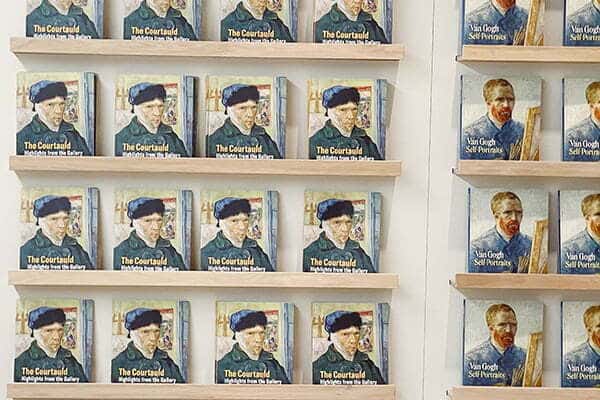

Vincent'due south Early on years – Netherlands 1853 – 1886
Vincent struggled to find a career where he felt he fitted in and proved useful.
He initially worked as an apprentice for International Dutch fine art dealers, Goupil & Co, but when he was dismissed, he moved to England to become an assistant instructor at a school in Ramsgate. 2 years afterwards, he defended himself to preaching living and assisting the poor under quite harsh conditions in Belgium.
Now more ever felt the need to be around art and artists. He had e'er drawn and loved being exterior, surrounded by nature, and so aged 27, encouraged by his blood brother Theo, Vincent decided to become an creative person.

Vincent van Gogh, Pollard Birches, Nuenen, Netherlands, March 1884
For the side by side three years, Vincent advisedly began to develop the skills needed to become an artist, relocating to Brussels in 1880 and later to The Hague. He enrolled on a course at the art university with the aim to learn as quickly as possible so he could make an income from his work.
He began working from the Cours de dessin, edited by Charles Bargue, a step by step classical drawing progression on the class. These are known equally the Barque Plates and are used in classical painting Ateliers for developing drawing skills.
He also took painting lessons in The Hague from the artist and colourist Anton Mauve, Vincent's cousin-in-constabulary. Mauve taught him the basics of using watercolour and oils. Sure his techniques were not good enough; Vincent practised fanatically.
In 1883 due to a lack of money, he was forced to motion back to the rural village of Nuenen, to live with his parents. Information technology proved to be an platonic setting equally he could observe and paint farmers, labourers and weavers within the landscape. He sketched and painted at every opportunity, the work distinctly nighttime, mostly in world tones.

Vincent van Gogh, Peasant Adult female Digging upward Potatoes, 1885
You tin see the subtle palette in this painting and how close in value a lot of the bailiwick is. This approach is a classical way of painting and painted en-plein air, it's similar in mode to The Hague School; they were known as the 'Grey Schoolhouse' due to the predominantly muted palette.
Letter of the alphabet 253 to Theo, Sat, 5 August 1882
Letters to Theo
Theo van Gogh was Vincent's younger blood brother and all-time friend.
He worked as a successful art dealer in Paris and wholeheartedly supported Vincent'southward fine art career. He gave him unfailing financial and emotional support, including a monthly assart, with the understanding Vincent would send him all of his artwork, and Theo would, in turn, try to sell them.
When Vincent and his brothers and sisters left abode, they all wrote to each other regularly. And they wrote hundreds of letters.
Vincent's letters to Theo are a detailed, poignant periodical about his personal struggles, daily life and work. Alongside his thoughts about fine art, Vincent would include sketches and ideas for paintings he was working on; he chosen them 'scratches'.
Vincent also sent Theo orders for sail, brushes and paint tubes from Paris,
'I must warn you that very shortly I'll need a big club for colours for the autumn, which I believe is going to be absolutely marvellous',
Vincent to Theo, Arles September 1888. (In April he had already ordered more than 100 pigment tubes)
I'thousand start to run across now how he painted so thickly with such carelessness! Theo was footing the bill!
Theo kept every 1 of these messages from his brother (651 in total). The majority of Theo'south correspondence back is filled with encouragement; he was i of the few people who actually understood Vincent and was ofttimes concerned about his blood brother's mental condition and health.
Paris 1886
In 1886, Theo asked Vincent to come and live with him in Paris, and from March, they shared an apartment in Montmartre. Here, he could introduce Vincent to his circle of colourful artist friends, Émile Bernard, Paul Gauguin, Camille Pissarro and Henri de Toulouse-Lautrec.
Van Gogh was exposed to and influenced by Impressionists, Symbolists, Pointillists, and Japanese fine art.
From his earliest work in the Netherlands which was dark and heavy, van Gogh began to employ a lighter palette and expressive brushstrokes to capture low-cal and movement.
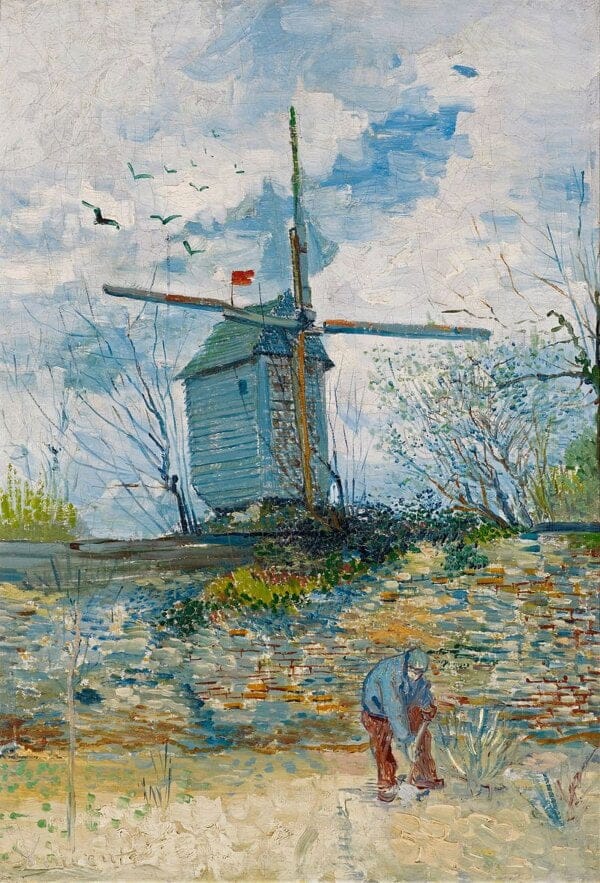
Vincent van Gogh, Le Moulin de la Galette 1886
Van Gogh had started to learn some of the basics of oil painting, so this was painted just a yr later than the previous painting of the Women digging Potatoes. You lot tin run across the impression Paris fabricated on him reflected in this painting and the signature Van Gogh yellow and blueish combination in the colours on the wall. Some of his more classical painting techniques are all the same there with the cute painterly sky.
The portrait exhibition includes self-portraits made during those early years in Paris, alongside later works created later on Vincent's motion to the Arles, Due south of France, the most turbulent period in his life.
South of France 1888
In February 1888, tired of city life and longing for a warmer climate, Vincent decided to motility to Arles, S of France.
The Provencal mural provided an ideal setting for Van Gogh. In letters to Theo, he expressed his delight at the sunlight, bright colours, landscape and affluence of flowering copse when he arrived in Arles. His painting style adult, it became looser, and he used bold experimentation and more expressive marks.

You can see how the intensity of colours are merging, and I actually beloved the ground underneath the tree; it reminds me of a Monet or Pissarro. It's got lovely colours in the shadows and muted imperial hues. This particular painting was dedicated to Anton Mauve, who taught him so much nigh the foundations of painting techniques.
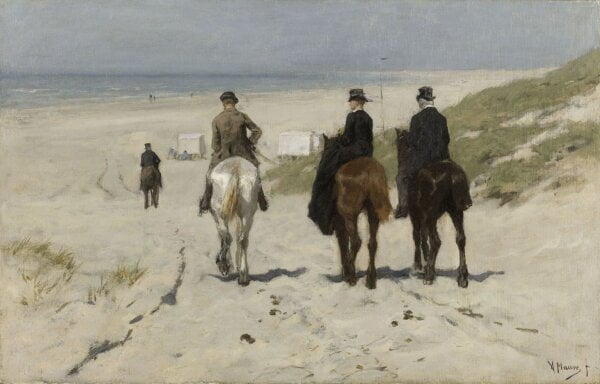
Anton Mauve, Morning Ride on the Embankment (1876), oil on canvas
A place where artists volition feel at habitation
His ambition in Arles was to create a community of artists. He envisaged artists working together in a brotherhood, including his friend Paul Gauguin.
Gauguin finally arrived in the South of France in late October 1888, but only after much persuading. (Theo ended up paying for Gauguin'southward travel expenses to get him at that place.)
With the dream to create an artists' house, where agreeing painters could live and piece of work together, Vincent rented four rooms in the 'Yellow House' on Place Lamartine. In grooming for Gauguin's inflow, he painted huge sunflower paintings to decorate the walls,
'So Gauguin's coming; that will make a big change in your life. I hope that your efforts will succeed in making your house a place where artists volition feel at home.'
Theo to Vincent, Paris, nineteen October 1888
And in the offset, it worked.
They painted side by side, inspired one some other, ate and drank absinthe together.
Yet, their very dissimilar characters acquired frequent disagreements, and growing differences in their creative views led to heated discussions. Vincent began to display signs of agitation, his mental wellness deteriorated, and he became alarmingly eccentric.
Paul Gauguin was the only creative person to ever movement into the yellow house; crippled with self-doubtfulness; the pressure level became too much for Vincent.
After only nine weeks, Gauguin threatened to go out. Vincent fell ill and cut off his ear. He was and then hospitalised in Arles twice over the next few months.
In May 1889, following a serial of relapses in his mental health Van Gogh understood his fragility and voluntarily entered a psychiatric hospital nearly Saint Remy. During this year, Vincent began working again. He was given a room to use every bit a studio and often painted outside in the gardens, completing effectually 150 paintings that yr.
The following Summertime, he moved closer to Paris to be near Theo but was exhausted from working as well hard and the unachievable high standards he set for himself. On 27th July 1890, in a field most Auvers-Sur-Oise, French republic, Vincent reportedly shot himself in the chest*.
He felt he had failed and was uncertain about his financial time to come.
He died two days subsequently, with his brother Theo at his bedside.
Throughout these years, Vincent produced many self-portraits; he made all 35 of his known self-portrait paintings in the final iv years of his life when he was between 33 and 36 years onetime.
The Portrait exhibition shows Vincent at his most self-enlightened and sometimes about vulnerable.
The Exhibition


Vincent van Gogh, Paris, jump 1887, Oil paint on artist'due south board
The first portrait that grabbed my eye was this one on the right-mitt side of the bear witness entrance, and information technology's got an incredible intensity to it. You tin can instantly run into the influence of pointillism and Seuret (who first adult this method of optical mixing of the colours) in this mass of broken colour.
Van Gogh uses the coloured ground every bit an extra layer to the painting method, leaving spaces for the eye to move and contrasting colours to feel like the background is fabricated of hundreds of fireflies!.
This refined cocky-portrait reveals the importance for Vincent van Gogh of the new pointillist technique pioneered by George Seuret. This involves the apply of dots of pure color placed side-by-side to create a vibrant paint surface.
The colours are often opposite on the colour wheel such as the complementary blues and oranges in the groundwork of this work.
Instead of rigorously post-obit Seuret 'southward method however, van Gogh used colour in an instinctive way wearing his brushstrokes to match his field of study matter.
The Courtauld, London

Vincent van Gogh, Self-Portrait with Straw Hat, Paris, Baronial-September 1887, Oil paint on artist's board

When you get close to the features, it's like the lines are sculpted around the form of the face, all the lines go in a clear direction of how the features are sitting. This painting has real power, and it'due south pretty small. Simply it felt like the eyes were following you lot around the room.
This has the same elements of having a ground color that remains mostly unpainted.
He is wearing a straw hat, and you see this in quite a few of the portraits. It reminded me of the Holbein exhibition and where the headwear is so essential to give yous a strong silhouette.
Vincent van Gogh represents himself from the same angle and wearing his large harbinger hat. Only his clothes change, instead of a workmen's jacket he now with the white shirt, bluish cravat and waistcoat with carmine pipe constitute in earlier portraits. He too plays with the colour of his features to experiment with contrast. He fifty-fifty depicts himself with 1 eye bluish and the other eye green complementing the orange and yellows of his beard and hat.
The Courtauld, London

Vincent van Gogh, Cocky-Portrait with Grey Felt Lid (particular) Paris, September-October 1887, Oil paint on cotton fiber canvas
The brushstrokes are placed down and then not mixed. And the placement of the marks replicates the contours of the confront. He's moved to the brushstroke next to it, and hasn't blended or smoked the paint. This is more than of similar a combination of the outset painting and the 2nd one we looked at, where at that place's less focus on creating a realistic rendering.
And there'south a lot more concern almost how the colours collaborate and repeated patterns. If you look at the groundwork here, there are a lot of lines of colours and a repeated blueprint of the blue lines and so the ruddy dots. Then when you look at the cheekbone in the shadow, you've got the same designs, a green line then a white.
Whereas van Gogh'south brushstrokes had previously followed the curve of his face they now radiate outwards from his nose which is the fundamental chemical element of this limerick. The result is enhanced by the large halo created around his head and lid past the orangish dots laid over a long blue strokes.
Technical examinations showed that this work was fabricated over several sessions suggesting van Gogh deliberated over his placement of colours and choice of effects. It also reveals new conviction in his skills and a willingness to push the boundaries of the art he'd seen made in Paris.
The Courtauld, London

Vincent van Gogh, Self-Portrait, Paris, autumn 1887, Oil paint on canvas
I liked the framing choice for this portrait. It'southward then like to the brushstrokes that Vincent was now using, and it besides reminded me of a woodblock print. His brushstrokes are like chisel marks in the wood.
This painting is closely related to the piece of work on the correct they share the same assuming hatching, added to enhance specific areas, carmine on the side of van Gogh'south olfactory organ to create a strong shadow and blue to draw attending to his eyes. This treatment makes every feature bristle with nervous energy and radiate with internal light.
Van Gogh's beau Painter Emile Bernard called these works his 'fiery faces'. They are the earliest cocky-portrait by van Gogh to be seen past the public at an exhibition he organised in a restaurant in the Monmarte commune of Paris in November 1887.
The Courtauld, London

Y'all've got this fabulous cleaved paint application over the summit of the drawing, and colours are the brokenness is what adds the visual involvement to it, using a dry brush application rather than glazing.
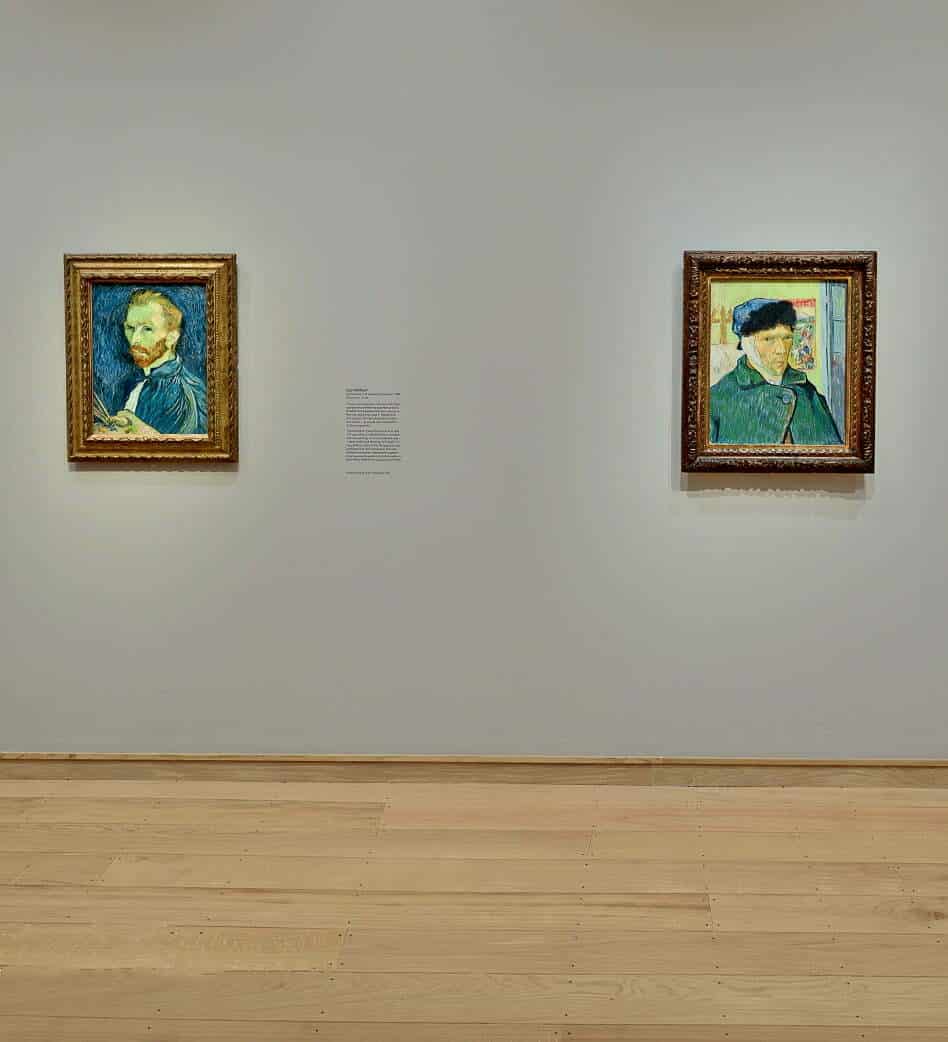

The infamous painting of Van Gogh with a bandaged ear. Protecting her son's ear with her right hand, it'southward similar she's seen the painting and got scared, I am faced with my ear.

Ear to Ear with Van Gogh.
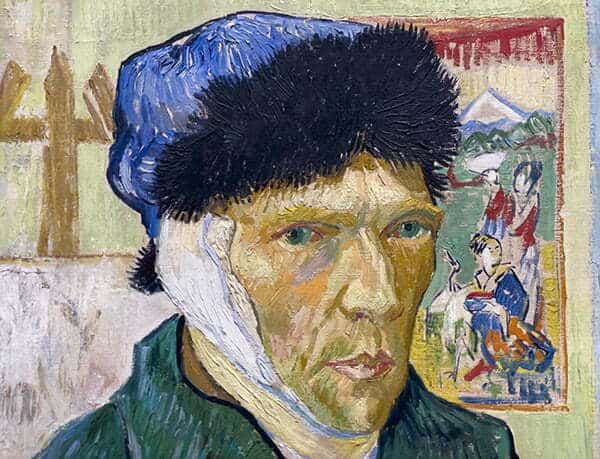
Vincent van Gogh, Cocky-Portrait with Bandaged Ear, Arles, January 1889, Oil pigment on canvas
This work is the only self-portrait by Vincent van Gogh with a recognisable setting. The artist represented himself in the pocket-sized studio gear up on the ground floor of his rented business firm in Arles. He is flanked past a canvas on an easel and a Japanese woodcut an of import source of inspiration. Van Gogh painted this work a week after leaving the hospital where he had received treatment following the mutilation of his left ear (shown here as his right as he e'er painted himself in a mirror)
This drastic act may take been precipitated by a dispute with his friend and housemate creative person Paul Gauguin
The self-portrait tin can be seen as a powerful argument on van Gogh's office but he has started working again, above all it is the artist'due south assured brushstrokes and bold colours that declare his renewed appetite equally a painter.
The Courtauld, London

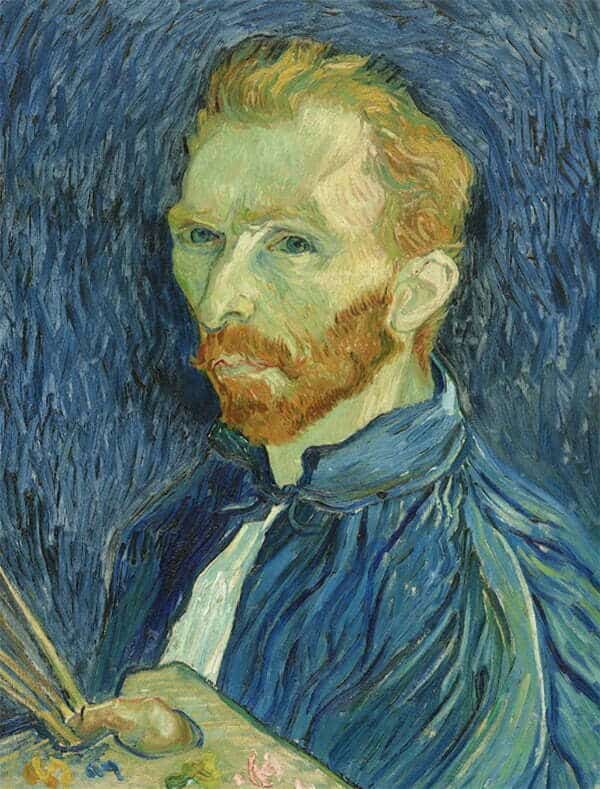
Vincent van Gogh, Cocky-Portrait, Saint-Remy, kickoff week of September 1889, Oil pigment on sheet
Yous can see the color palette has inverse from the realistic rendering of the first portraits to a yellow-toned skin. The background feels similar it's going to erupt into a starry night!
This is a rare example of Vincent van Gogh representing himself equally a painter at work. Brushes and a palette with four colours – the main pigments used in this portrait (the pink on the correct should be cerise simply has faded) – protrude from the bottom of the limerick.
This exhibition marks the first time in over 130 years that this self-portrait is reunited with the painting on the left painted only a week earlier merely showing van Gogh in a very dissimilar calorie-free. Here he appears more confident and less introverted.
The two self-portraits haven't been seen together since leaving the workroom in the asylum is Saint-Remy were van Gogh painted them.
The Courtauld, London

Vincent van Gogh, Self-Portrait, Saint-Remy, late Baronial 1889, Oil pigment on canvass
This change in the palette is besides seen in one of the terminal paintings hanging in the bear witness.
This felt like an extremely modernistic portrait and was non credited to Van Gogh for a while. (Not a Fake – The Fine art Newspaper)
You've got this confident, stiff contour line depicting the face up shape, which holds the whole portrait together. At that place is nice edge handling, how he has smoked the paint around the rear of his head that then melts into the background.
In the groundwork, you've got those angled zigzag lines that we've seen in the before pieces, and you lot've got lovely muted greens like his before colours from The Hague school.
It feels like it's similar a combination of all the styles that he's practised over the years.
In a letter to his blood brother Theo he described this painting equally an attempt from when I was ill. It was the showtime work he created post-obit a severe crisis in the summertime of 1889. As he had done earlier with self-portrait with bandaged ear, van Gogh returned to painting his ain features to help him regain his sense of identity.
'I firmly believed that if I recover it will be considering I've killed myself by working which fortifies the volition and consequently allows these mental weaknesses less hold.'
This was a courageous stance in the confront of great distress. The unusual graphic symbol of this work means that its attribution to van Gogh has long been doubted recent archival and technical examinations have confirmed its authorship adding a new dimension to van Gogh cocky-portraiture.
The Courtauld, London

Vincent van Gogh, Van Gogh's Chair, Arles, November 1888, reworked in January 1889, Oil paint on canvas
Van Gogh's painting of a rustic wooden chair in his house in Arles with the artist's pipe and tobacco pouch on the seat has long been seen as a symbolic cocky-portrait.
It was painted as a pair to become Gauguin'due south chair which depicts the walnut armchair used past the artist Gauguin when he was living with van Gogh. In contrast to Gauguin's refined seat, van Gogh's harbinger-bottomed chair is plain and humble, expressing the painter's long affinity with the peasant style of life.
This work conveys as much about van Gogh'south character and artistic identity as any of the self-portraits he made during his short career.
The Courtauld, London

Paul Gauguin, Te Rerioa (The Dream), 1897, Oil on Canvas
Hanging just outside the archway to the exhibition is a Gauguin painting. His old friend and inspiration, sitting adjacent to each other, just similar the artist colony he'd dreamt of.
The exhibition is on until the eighth May 2022 'Van Gogh. Cocky Portraits at The Courtauld, London 3rd Feb – 8th May 2022'
Yous might as well similar:
3 complementary colour tricks yous tin learn from Van Gogh
This two min video shows the right pronunciation of Van Gogh in Dutch!
*At that place is an alternate story that claims Van Gogh was actually shot by accident, detailed in the book Van Gogh: The Life by Steven Naifeh and Gregory White Smith.
Source: https://willkempartschool.com/how-to-paint-a-portrait-like-van-gogh/

0 Response to "Shes My Van Gogh Such a Work of Art"
Enviar um comentário